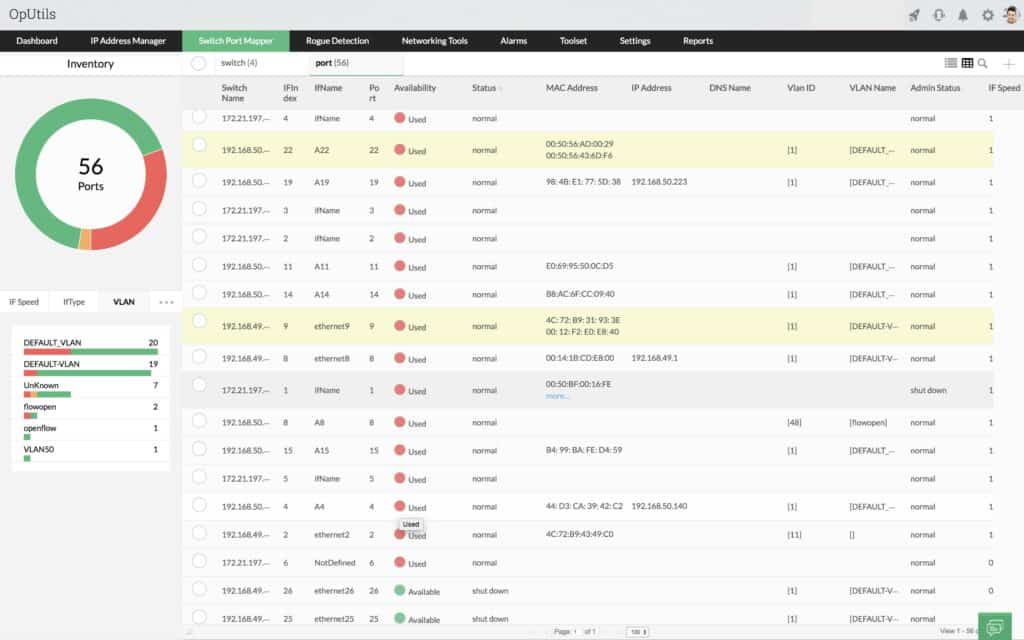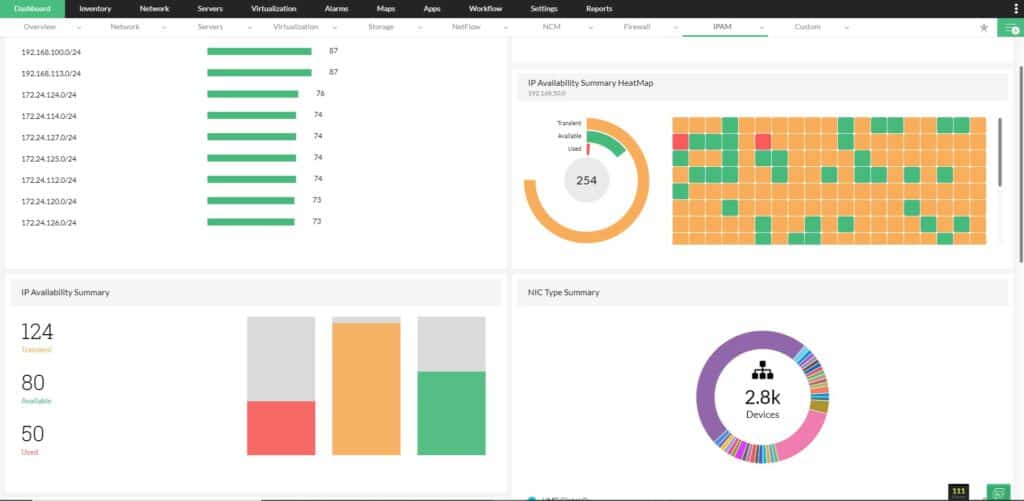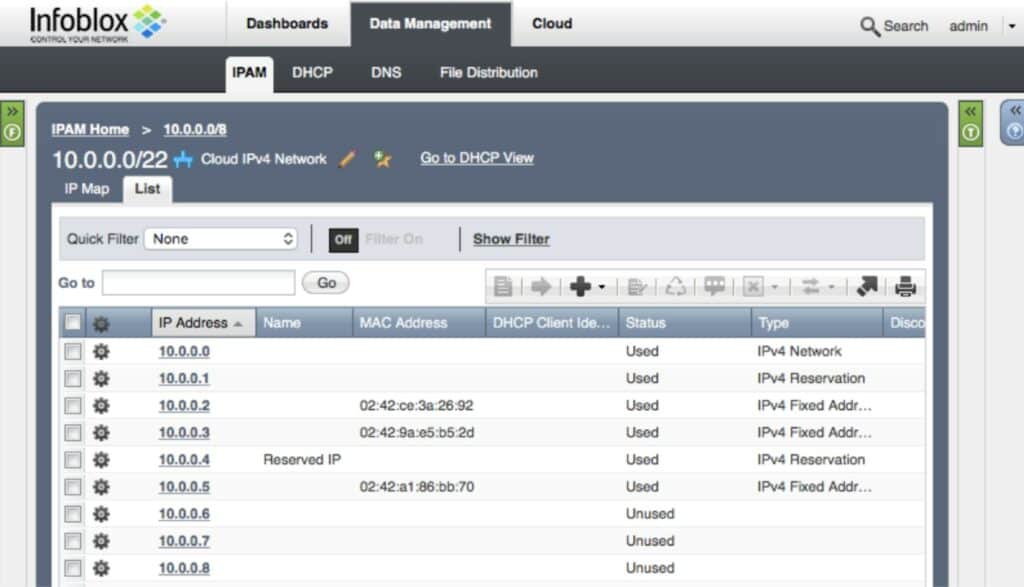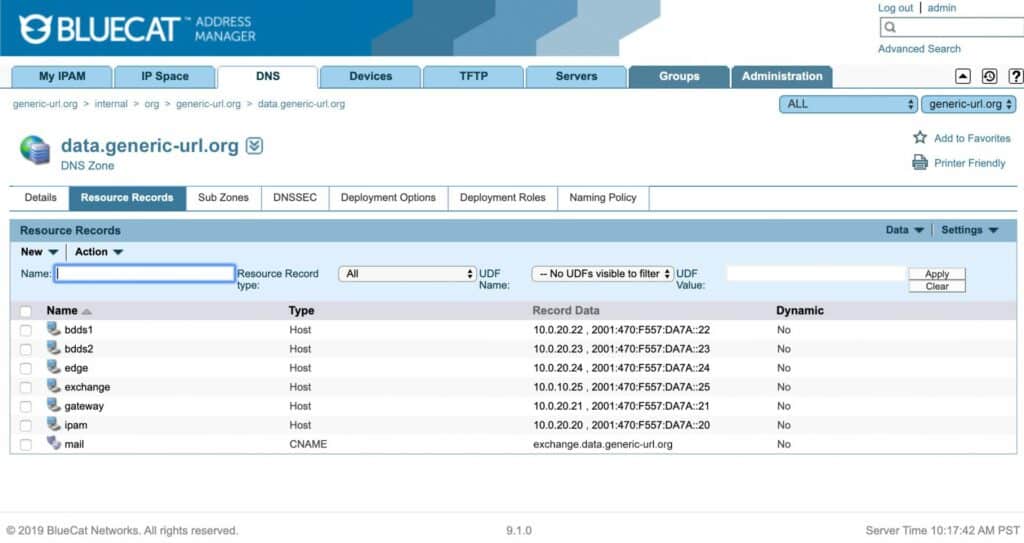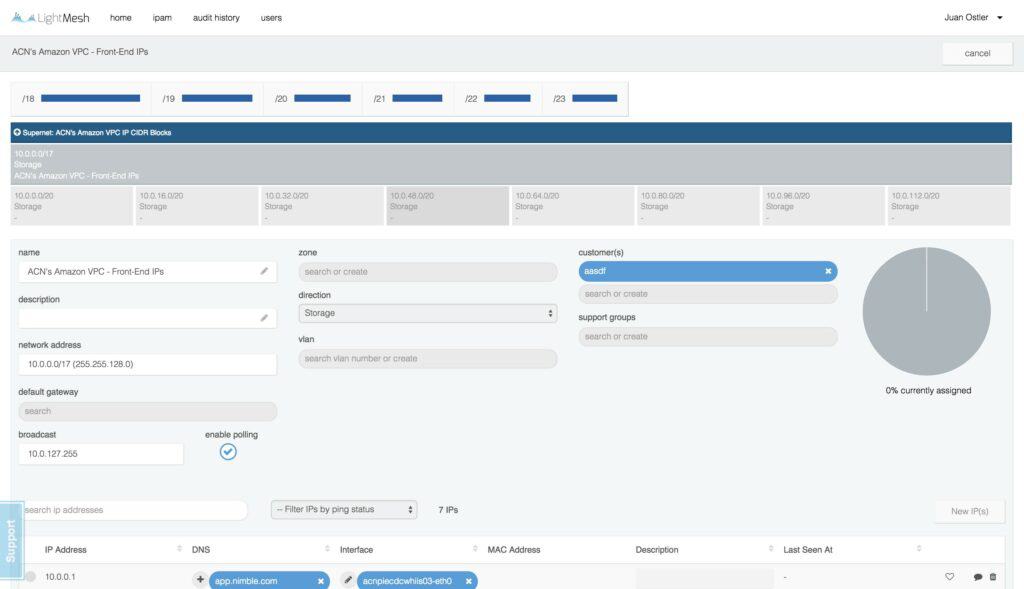Effective IP control is crucial for managing and securing a network, especially as organizations grow and the complexity of their IT infrastructure increases. With the ever-expanding use of IP addresses across networks, controlling and tracking them efficiently is essential to maintain security, prevent unauthorized access, and ensure smooth network operations. This is where IP control tools come into play.
IP control tools help administrators manage, track, and allocate IP addresses, enabling them to optimize their network infrastructure and maintain effective security protocols.
Here is our list of the best IP control tools:
- ManageEngine OpUtils EDITOR’S CHOICE IP address and switch port management software with IP address discovery. Start a 30-day free trial.
- ManageEngine OpManager IPAM and SPM Add-on (FREE TRIAL) Network monitoring software with an IPAM add-on. Includes reports. Start a 30-day free trial.
- Infoblox IPAM IP address management tool with custom reports and automated workflows.
- Bluecat Address Manager DDI solution that can manage IPs and automatically provision IPs for new VMs and workloads.
- LightMesh IPAM IPAM software with network discovery and user permissions.
- BT Diamond IP Managed IPAM service that supports multi-cloud setups.
- GestióIP IPAM Web-based IPAM with support for IPv4 and IPv6 IP addresses.
In this guide, we’ll explore the best IP control tools available in the market today. From automated IP address management to advanced network visibility features, these tools provide a variety of solutions to streamline and secure IP address allocation and management. Whether you’re dealing with a small network or a large enterprise setup, choosing the right IP control tool can significantly improve network reliability, reduce downtime, and enhance security posture.
We’ll cover key features of each tool, such as support for DHCP, DNS management, network scanning, and the ability to easily track and manage IP address usage. Additionally, we’ll evaluate their scalability, ease of use, reporting capabilities, and integration with existing network infrastructure.
By the end of this guide, you’ll have a better understanding of the various options available for managing your IP space, and how to choose the right tool to ensure network stability, security, and efficiency. Whether you’re a network administrator or an IT manager, this overview will help you make an informed decision to keep your network running smoothly.
The Best IP Control Tools
Our methodology for selecting an IP control tool
We reviewed the market for IP address management systems that will give you full IP control and analyzed tools based on the following criteria:
- An IP address manager
- The inclusion of DHCP and DNS servers or coordination with external servers
- Systems that can also scan switch ports to identify connected devices
- Identification of rogue devices
- Updates to IP address pools
- A free trial or a demo package for a no-obligation testing opportunity
- Value for money from a system that will fully control IP address management at a fair price
With these selection criteria in mind, we identified IP address managers and switch port mappers that will help you keep full control of your network’s IP address distribution and usage.
1. ManageEngine OpUtils (FREE TRIAL)
ManageEngine OpUtils is a web-based IP address management solution that supports IPv4 and IPv6 IP addresses. ManageEngine OpUtils periodically scans your network to identify whether an IP address is available or not. The platform comes in a hierarchical tree view, which lets the user create tree nodes and add subnets to them. You can also view a table of the status of IP addresses and subnets detailing the last scan time.
Key Features:
- IP Address Management: Offers a dynamic and integrated approach to tracking and managing both IPv4 and IPv6 addresses.
- Switch Port Mapper: Simplifies the task of identifying and administering network switch ports.
- Device Discovery: Automates the detection of new devices on the network, enhancing operational efficiency.
- Audit Trail: Maintains a detailed log of IP address changes, supporting effective audit and compliance processes.
Why do we recommend it?
ManageEngine OpUtils combines an IP address manager and a switch port mapper. This is not quite as comprehensive as the SolarWinds package because you need to interface the package to external DNS and DHCP servers to fully automated IP address management. The system lets you examine and administer switch ports.
When scanning IP addresses, ManageEngine OpUtils gathers a range of information including system name, DNS name, MAC address, status, owner, device type, and more. All of this information tells you everything you need to know about the IP address and the component it represents.
To create a track record of IP changes, ManageEngine OpUtils has an IP history feature. The feature logs the time and date of changes made to records including who the IP was allocated to and when. Pulling up the history of an IP is useful for having a paper trail to point to in auditing.
Who is it recommended for?
This package isn’t as extensive as the SolarWinds system but it is cheaper, which makes it more accessible to small businesses. Like the SolarWinds bundle this package runs on Windows Server. It will also run on Linux and AWS. There is a Free edition that provides a Ping system for manual IP address management.
Pros:
- Comprehensive Tool Suite: Combines Wake-on-LAN, IP address management, and physical switch port mapping for robust network administration.
- Detailed Information Gathering: Collects essential data such as hostname, device status, and MAC address during IP address scans.
- Effective Autodiscovery: Automatically detects new machines, making it ideal for expanding or dynamic network environments.
- Cross-Platform Availability: Supports both Windows and Linux servers, ensuring wide usability.
Cons:
- Complexity for New Users: The extensive range of tools and features may require a learning curve for those new to ManageEngine’s platform.
ManageEngine OpUtils is a cost-effective IPAM solution that’s easy to use and navigate. You need to contact the company directly for pricing information. The software is available for Windows and Linux. You can download the 30-day free trial.
EDITOR'S CHOICE
ManageEngine OpUtils stands out as our premier selection for IP address and switch port management due to its comprehensive toolset and accessibility. Its integration of IP address management and switch port mapping into a single, web-based platform offers a level of convenience and efficiency not readily found in other packages. What I found particularly appealing was its capability to periodically scan the network, identifying the availability of IP addresses, and the inclusion of a detailed audit trail feature.
I found this especially beneficial for maintaining a secure and well-organized network infrastructure. The platform’s support for both IPv4 and IPv6, along with its ability to run on diverse environments like Windows Server, Linux, and AWS, makes it a versatile solution for a wide range of users.
Although it may require interfacing with external DNS and DHCP servers for fully automated IP management, its cost-effectiveness and the provision of a free edition make it an attractive option for small businesses seeking to optimize their network management processes without significant investment.
Download: ManageEngine OpUtils Free Trial
OS: Windows Server, Linux, AWS
2. ManageEngine OpManager IPAM and SPM Add-on (FREE TRIAL)
ManageEngine OpManager IPAM and SPM Add-on is a network monitoring platform that comes with an IP address management and switch port mapper add-on. With the IPAM and SPM Add-on for ManageEngine OpManager, you can view the system name, DNS name, MAC address, device type, and state of IP addresses throughout your network.
Key Features:
- Integrated IP Management: Offers comprehensive management of IP addresses, enhancing network visibility.
- Switch Connectivity Mapping: Visualizes connections between devices and switch ports, simplifying network management.
- Seamless Active Directory Sync: Automatically syncs with Active Directory for enriched IP address data.
Why do we recommend it?
ManageEngine OpManager is a network device monitoring package and you can add OpUtils to that service to get IP address management and switch port mapping as well. The combination of these services gives you full visibility of your IP devices. You could also add on the NetFlow Analyzer to get bandwidth monitoring.
You can also create reports that detail the status of your IP addresses. For example, you can view the number of Used IPs, Transient IPs, Available IPs, and Total IPs. These reports can be generated manually or scheduled. Reports can be exported in CSV and XLS format so you can share your findings with the rest of your team.
The tool also integrates with Active Directory. The integration automatically looks up IP addresses to see if they refer to Active Directory objects. If the IP address is connected to an AD object then you can view additional information such as OS Name, OS version, created time, last login, and more.
Who is it recommended for?
If you need an IPAM and you already use OpManager, it makes sense to add OpUtils to it. The OpManager software will run on Windows Server, Linux, AWS, and Azure. However, OpUtils won’t run on Azure, so if you want to integrate these two systems, you have three platform choices.
Pros:
- Automatic IP Insights: Generates detailed metrics on IP usage, conflicts, and availability effortlessly.
- Enhanced Device Monitoring: Utilizes ping and SNMP to monitor device status and performance accurately.
- Dynamic Network Mapping: Automatically creates and updates network topology maps for real-time visibility.
- Advanced Log Analytics: Captures and analyzes logs for in-depth network insights beyond standard tools.
Cons:
- Complexity for Novices: Its rich feature set and professional-grade tools can be daunting for those without technical expertise.
ManageEngine OpManager IPAM and SPM Add-on is worth considering if you’re in the market for a network monitoring tool but want to incorporate IPAM as well. The software is available on Windows and Linux. Paid versions start at $245 (£185) for 10-1000 devices. You can download the 30-day free trial.
3. Infoblox IPAM
Infoblox IPAM provides a central platform for managing IP addresses and DHCP servers. With Infoblox IPAM you can automatically detect and provision unmanaged devices in real-time. You can view IP addresses and MAC addresses alongside the device to which they correspond. The tool also supports Active Directory so you can easily match users to IP and MAC addresses.
Key Features:
- Effortless Device Discovery: Automatically identifies and catalogs unmanaged devices in real-time.
- IP Address Oversight: Streamlines management of IP addresses for improved network control.
- Rogue Device Detection: Actively identifies and flags unauthorized devices on the network.
Why do we recommend it?
Infoblox IPAM is available as part of a DDI package, which is offered as an on-premises software package and as a SaaS platform. The system automatically reconciles addresses with DHCP and DNS servers and it helps you to create subnets. The tool will also spot rogue devices on your network.
Configuring Infoblox IPAM is fairly straightforward. Use customizable templates to configure your monitoring environment rather than configuring everything from scratch. Features like custom reports allow you to take a closer look at the status of IPs in your network. You can even create customizable workflows to automate manual processes.
Who is it recommended for?
Infoblox provides a competent DDI and you can connect it to your access rights manager to link user details to device identifiers. The choice of on-premises and cloud-based hosting expands the potential customer base of the tool. This service can help with security monitoring, system auditing, and compliance reporting.
Pros:
- Unmanaged Device Identification: Excellently suited for MSPs to streamline new client network setups.
- Active Directory Compatibility: Seamlessly integrates with LDAP Active Directory for enhanced user-device mapping.
- Automated Task Workflows: Enables creation of custom workflows to automate routine network administrative tasks.
- Extended Trial Offering: Offers a generous 60-day trial, allowing ample time for evaluation.
Cons:
- User Interface Complexity: Falls short in user-friendliness compared to other top-tier tools in the market.
- Additional Cost for Reports: Reporting functionality requires separate purchase, not included in the base package.
Infoblox IPAM is worth looking into if you’re looking for scalable IP control tools. Contact the company directly for pricing information. You can try the 60-day free trial.
4. BlueCat Address Manager
BlueCat Address Manager is a piece of DDI software that combines DNS, DHCP, and IPAM. Through the web-based interface, you can manage IP addresses throughout your network. The software automatically provisions the correct IP address and DNS name for new VMs or workloads.
Key Features:
- Comprehensive IP Management: Centralizes management of IP addresses, DNS, and DHCP services.
- Automated Address Allocation: Automatically assigns IP addresses and DNS names to new virtual machines.
- Efficient Address Pool Management: Streamlines the administration of address pools for optimal network organization.
Why do we recommend it?
BlueCat Address Manager is a DDI that includes an IPAM along with DNS and DHCP servers. This system is able to manage IP address complexities for virtual environments and its abilities give you options over implementing strategies, such as creating a hyperconverged network that includes cloud-based systems.
You can view a table of Active IP addresses throughout your network detailing the Host Name, Address Name, MAC address, IP Group Name, IP Group Range, Device, Lease Time, Expire Time, Location, and Description associated with the entity. Having this information on hand helps you to see what IPs have been assigned to what infrastructure.
Who is it recommended for?
BlueCat Address Manager is a good service for businesses that want to move network management into virtual options. The system is based on your network, but it can implement strategies to include remote users and services, creating a wider, hybrid network. Combine user tracking with IP address management.
Pros:
- Web-Based Access: Enables network management from any location via a web interface.
- Detailed DHCP Monitoring: Simplifies tracking of DHCP leases, IP utilization, and device details with minimal setup.
- Flexible Deployment Options: Supports both physical and virtual deployment scenarios.
Cons:
- Pricing Transparency: Pricing information requires direct contact with sales, lacking upfront clarity.
- Interface Usability: The user interface could be more intuitive, especially for saving settings and navigating.
- Support Resources: A broader range of knowledge base articles would enhance support for new users.
BlueCat Address Manager is an accessible and scalable IP control tool that’s recommended for midsize organizations. The solution can be deployed as a physical or virtual server. If you want to view pricing information you will have to request a quote from the company directly. You can contact the company from this link here.
5. LightMesh IPAM
LightMesh IPAM is an IPAM platform that can scan your network for IP addresses within your network. Discovered IPs can be viewed as part of graphical subnet visualizations that provide you with a top-down perspective of your infrastructure. You can also use the subnet builder to build your own subnet structure.
Key Features:
- Graphical Subnet Overview: Offers a visual representation of network subnets for easy comprehension.
- Historical IP Tracking: Keeps a record of IP address assignments and changes over time.
- Scalable Network Management: Designed to efficiently handle the complexities of large-scale networks.
Why do we recommend it?
The LightMesh IPAM is a network solution that forms a part of a platform for managing access to applications. The pricing for the system is based on the number of applications that you manage, which amplifies the focus of the tool. You can integrate cloud systems into your on-premises network with this tool.
The user experience is very straightforward. In one-click, you can allocate the next IP in a subnet. If you need to support a team of users then you can assign permissions to different users to control what infrastructure they can manage. Users can manage particular subnets and IP ranges to allocate resources as required.
To assist with auditing, LightMesh IPAM displays the history of IP addresses. You can view user actions or when the information was added. For example, you can see when an IP or subnet was added or removed. Having the option to view IP address history lets you track how your resources have been managed over time.
Who is it recommended for?
Tidal LightMesh provides a way to migrate applications to the cloud. This can be assisted by implementing a virtual network over hybrid resources and that is where the IPAM can help. This package is expensive and way beyond the budgets of SMBs. So, this is a solution that is aimed at large organizations.
Pros:
- Intuitive Visual Mapping: Graphically organizes devices and subnet assignments for straightforward network visualization.
- Collaborative Team Features: Facilitates team-based network management with customizable user access and permissions.
- Comprehensive Audit Trails: Provides detailed logs of user actions for enhanced accountability and operational insights.
- Enterprise-Focused Design: Optimally caters to the needs of large enterprises or managed service providers.
Cons:
- Limited Small Network Utility: Features aimed at team collaboration may be underutilized in smaller network environments.
LightMesh IPAM is a reliable IPAM solution with a scalable pricing model. Prices start at $200 (£151.46) per month for two users, 50 subnets, and 10,000 IPs up to a custom price tag for unlimited users, IPs, and subnets. You can start the 30-day free trial.
6. BT Diamond IP
BT Diamond IP is an IPAM solution that manages IPv4 and IPv6 IP addresses. BT offers a managed service where you can outsource your IPAM management with 24x7x365 monitoring and deploy hardware appliances for PAM, DHCP, and DNS. You can also deploy virtual appliances and monitor them through the IPControl appliance dashboard which provides a summary of your infrastructure status.
Key Features:
- Hybrid System Support: Manages IP addresses across both physical and virtual systems.
- Managed Service Availability: Offers an option to outsource IPAM management with round-the-clock monitoring.
- Cloud Integration: Facilitates addressing for cloud-based resources, supporting a broad array of cloud platforms.
Why do we recommend it?
BT Diamond IP supplies a DDI solution, which includes security measures. This is a particularly good product for businesses that operate hybrid environments because it supports the integration of cloud services into the network. The system is also available as a managed service, which removes the need to have in-house network management expertise.
The service supports multi-cloud IPAM and comes with virtual appliances for AWS, Azure, Oracle VM, VMware, Hyper-V, and more. The range of cloud services supported makes BT Diamond IP a fit for cloud environments.
Who is it recommended for?
This tool has some good deployment options. You can host it as a VM as a virtual appliance or run it on AWS, Azure, or Oracle Cloud. The managed service is an interesting option that could also be a pass-through service for MSPs to offer to their clients.
Pros:
- Flexible Deployment Options: Can be utilized as a standalone tool or a fully managed service, accommodating a variety of operational models.
- Comprehensive Cloud Support: Adapts to multi-cloud environments, making it ideal for complex network infrastructures.
- Versatile for Various Organizations: Well-suited for businesses leveraging extensive cloud services or MSPs offering managed IPAM solutions.
Cons:
- Pricing Clarity: Direct engagement with sales is necessary to obtain pricing details, lacking upfront transparency.
- Managed Service Investment: Opting for the managed service may incur higher costs compared to managing IPAM in-house.
BT Diamond IP is a good choice for enterprises that want to take a more hands-off approach to monitor IP addresses and benefit from the support of a managed service. To find out pricing information on the BT Diamond IP service you will have to contact the company.
7. GestióIP IPAM
GestióIP IPAM is a web-based IPAM solution that supports IPv4 and IPv6 IP addresses. The software uses SNMP to discover devices in your network. With GestióIP IPAM you can view a list of IP addresses by going to the host list view. The host list view shows the IP addresses alongside other information including hostname, description, site, type, AI, comment vendor, and OS.
Key Features:
- Cloud-Based Delivery: Provides IP address management functionalities directly from the cloud.
- Automated SNMP Discovery: Utilizes SNMP to automatically discover and catalog network devices.
- Detailed IP Auditing: Tracks and records the history of IP address allocations and network changes.
Why do we recommend it?
GestióIP IPAM is a cloud-based tool that is able to discover and manage assets on multiple sites. This is an IP address manager and it will integrate with your exisiting DNS and DHCP servers. This system can help you manage subnets and VLANs and it will keep track of network device availability.
There is also an auditing feature, which allows you to view the history of networks and hosts. Here you can view a list of IP addresses and network events. Being able to go back to old events helps you to evaluate your IP management strategy and keep track of changes that have occurred to your environment.
Who is it recommended for?
This is a good system for managing an on-site network and even multiple networks. It doesn’t manage cloud services and won’t assist you in techniques such as hyperconverged networks or SD-WANs. An advantage is that it will simultaneously provide performance monitoring.
Pros:
- Accessible Web Interface: Enables easy access and monitoring from any location via a browser.
- Comprehensive Auditing Capability: Facilitates detailed tracking of network changes and IP address history.
- Cost-Effective Solution: Available as a free tool, offering significant savings for IP address management.
Cons:
- Feature Limitations: Lacks some of the advanced features found in premium IPAM solutions.
- Interface Usability: Could benefit from improvements in navigation and user experience.
- Lack of Advanced Monitoring: Does not offer the proactive monitoring and automation capabilities present in other IPAM tools.
GestióIP IPAM is a tool worth looking into if you desire a free IPAM solution. It’s easy to use and has the basics to help you monitor how your IP addresses are used. You can download the program for free.
Which are the best IP control tools for you?
Managing IP addresses with spreadsheets is a poor way to go. IP Control tools and IPAM tools are a must for enterprises that want to discover and assign available IP addresses easily.
IP control tools FAQs
How do I control my IP address?
The control of IP address distribution is performed by a suite of tools that is known as DDI. The DDI acronym stands for DNS, DHCP, and IPAM. The DHCP server allocates an IP address to a device that connects to the network. The settings of that server restrict the range of available IP addresses. IP addresses are allocated for a limited period, then, if the device is still connected, the address allocation is extended or the device is allocated a new IP address. An IP address manager scans the network to discover which addresses are in use. If an address that has been allocated is not detected, that device must have disconnected from the network, so the IP address is flagged as available for reuse. The allocation of addresses to devices needs to be cross-referenced to hostnames and this lookup table is held in a DNS server.
What is IP and why it is used?
IP stands for Internet Protocol. The IP abbreviation is most frequently encountered in the term “IP address.” The IP address is a unique address that identifies a device on a network. However, that uniqueness only applies within an address space. Therefore, while addresses on the internet have to be unique throughout the world, IP addresses on a private network only have to be unique within that network.
What is an IP management tool?
An IP management (IPAM) tool scans a network to identify which IP addresses are in use. This list is then reconciled with the list of addresses that the associated DHCP server has allocated. If the IPAM detects an IP address that wasn’t allocated by the DHCP server, it has discovered an unauthorized device connected to the network. If an address that the DHCP server records as being in use isn’t found to be active on the network, that IP address has been abandoned and the DHCP server returns it to the pool of IP addresses that are available for allocation.


